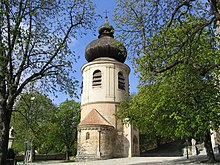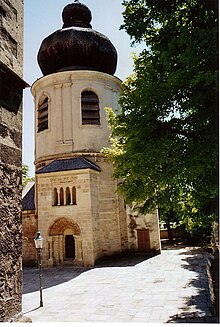Karner (Mödling)
The Pantaleon Chapel from the 12th century in Mödling is known as Karner .
Building description and history
In the 12th century there was a Romanesque church on the site of today's Othmarkirche . There was a cemetery to the south of today's church square. There, the left Babenberg Duke Heinrich the Elder from Mödling to 1182 a Romanesque the holy Panteleimon consecrated round chapel with an apse build.
The interior of the chapel has a diameter of approx. 8 meters, the basement is 8 meters deep, the original wall height was 8 meters. The roof was in the shape of a cone. After 1252 the chapel was raised by one fathom (1.90 meters) under Gertrud, niece of the Babenberg duke Friedrich II . The two construction phases can be clearly seen on the outer walls. The original building was made of hewn ashlars, the upper part is made of rubble stones.
The late Romanesque, round-arched step portal dates from after 1252. A spiral frieze, a pipe frieze with human heads and grimaces, a lily frieze and a pincer frieze runs from the outside to the inside. Similar motifs can be found in Klein-Mariazell at the north gate, at the west portal of St. Stephen's Cathedral in Vienna and at the south gate of the cathedral in Wiener Neustadt . The distinctive knot pillars were probably not created until around 1900.
In a document from 1346 the Pantaleon Chapel is called Karner , which is still the name in use today.
After the second Turkish siege there were plans to tear down the Karner and replace it with a bell tower. However, there was not enough money for it. Therefore, the Karner was only increased and it received a double bulb roof, this work was completed in 1698. The Karner has been used as a bell tower for over 300 years .
Basement
The basement of the Pantaleon Chapel served as an ossuary . At the time of the Turkish siege in 1683, many people fled to this vault and died there. The underground room was walled up and forgotten. Mayor Joseph Schöffel had the rediscovered room opened in 1884 . Bones, remains of clothing, prayer books, rosaries, remains of dishes and a well-preserved earthenware jug with dried-up remains of red wine were found.
interior
Originally the interior of the chapel was richly decorated with frescoes. These were covered with plaster and the paintwork was so damaged that only remains are left today.
The dome fresco in the apse shows the Virgin Mary with the baby Jesus in her right arm. The child's arms and body form a cross, which indicates the child's later fate. The child blesses the wise men from the east . The position of the fingers of the hand of blessing corresponds to the gesture of blessing of the Eastern Church. Two smaller non-biblical figures are shown to the left of Mary. Possibly it is Heinrich the Elder von Mödling and his wife Richza von Böhmen .
Peal
There were originally four bells in the Karner bell tower, of which three bells from the Baroque period are still preserved today: the Liebfrauen bell (2200 kg), the Othmar bell (1100 kg) and the Christophorus and Pantaleon bell (800 kg) . During the Second World War the bells had to be delivered , the smallest did not come back. On the occasion of Mödling's 1100th anniversary, the Restituta bell (475 kg) was cast in honor of the blessed sister Maria Restituta and was blessed on November 16, 2003.
Web links
- The Karner. In: othmar.at. Parish St. Othmar(detailed treatise on the Karner).
Coordinates: 48 ° 5 ′ 5.5 ″ N , 16 ° 16 ′ 47.5 ″ E


